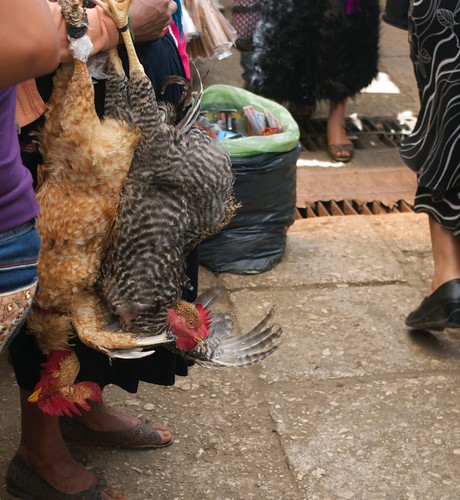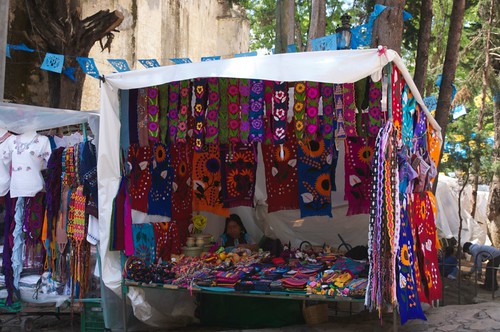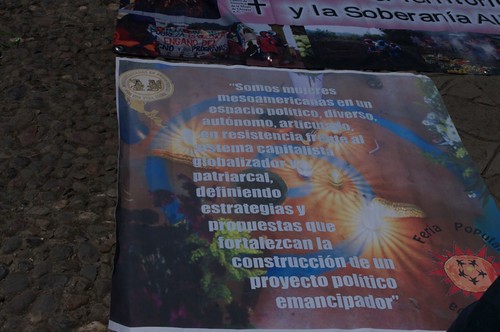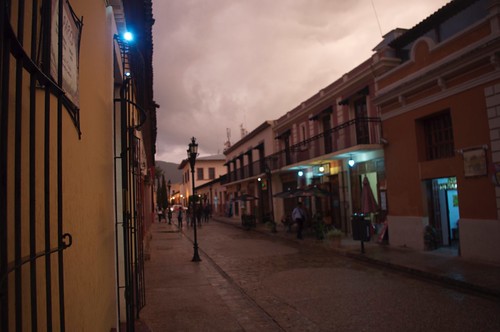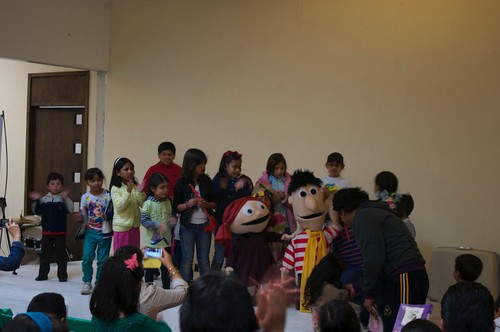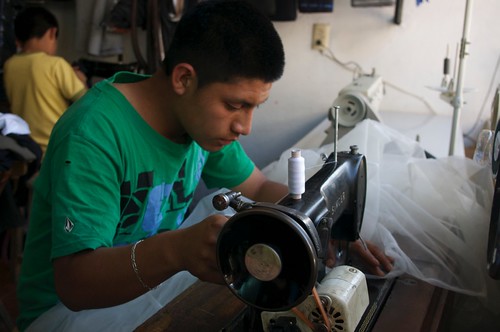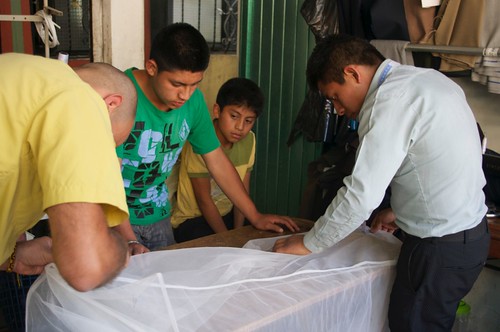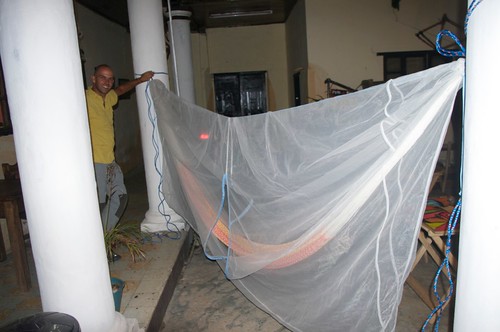Graças à boleia do Luis, a nossa chegada a San Cristóbal de las Casas foi uma das mais frescas que tivemos faz tempo. Ainda de dia e com tempo, deixámos a periferia da cidade e mergulhámos na parte antiga, literalmente descendo uma pequena ladeira que nos levava à Calle Insurgentes. A topologia da cidade mudou subitamente e as casas eram exclusivamente em alvenaria de pedra, a par com as igrejas que ladeavam as praças aqui e ali, ao longo da rua.
Uns punhados de quarteirões e chegamos à praça principal da cidade, donde a catedral se via de lado num dos lados, e nos topos arcadas, ora de um lado com cafés ora do outro com ofícios administrativos. Aí nos sentámos nuns bancos de jardim e comemos a fruta que nos restava, vendo a vida passar. E a vida era muita e diversa. Entre senhoras pequenas e crianças pequenas em venda ambulante de joias, pulseiras, canetas e porta-chaves, tortilhas e amendoins, começávamos a notar a internacionalidade do lugar. Intercalando os locais seja vestidos de trajes mais tradicionais ou encorpando coisas mais europeias, turistas e ou expatriados das mais diversas cores e feitios, falando outras tantas inúmeras línguas tornam San Cris um sítio ainda mais exuberante. Mas isto não é conclusão que se tire num só dia.
Na curta hora que ali ficámos, ganhámos umas pulseiras, três pacotes de amendoins, uma conversa com uma israelita e uma direção. O andador guadalupaño teria um café onde poderíamos ficar mais um pouco a ver a cidade de outro ângulo e ligarmo-nos à internet e tentar falar com o Oscar, o warmshowers da cidade. Aí esperámos até quase ao anoitecer pela sua resposta e decidimos tomar um hostel que é famoso pela sua hospitalidade para com os ciclistas. O antigo El Hostalito – agora Bici Nomada, donde a Lorena que nos havia interpelado às portas da cidade mais cedo, chegou a par connosco e nos acolheu e acomodou numa divisão fechada de propósito para termos um espaço privado. E assim começou mais um período sedentário no México.
Há algo de especial na mescla que San Cristóbal oferece a quem passa. E não é necessário ter porta-voz o convite a ficar mais tempo. Apesar de ser muito pequena para cidade, tem uma oferta equiparável apenas à existente no DF. E muito mais conveniente pelo tamanho minúsculo. Tudo à distância de um passeio. Cafés culturais, associativos, cinéfilos ou gourmet; escolham e vão ter um espécimen melhor e mais barato do que alguma vez encontrariam perto de casa. Para não falar da qualidade do próprio café, para além de moído na hora, é tostado no dia e colhido (quiçá) na semana passada! Chamar-lhe aromático é modéstia pura. Restaurantes italianos, franceses, hindus, argentinos, venezuelanos ou colombianos, de tapas espanholas ou bares de vinho, cada um com melhor pinta que o outro, e um mercado cheio de produtos frescos e orgânicos, vendidos por agricultores que diariamente descem as montanhas até à cidade, ou artesanatos em tecido, couro ou rede que se oferecem aos turistas por preços módicos.
Ali facilmente se deixa passar o tempo sem fazer nada, apenas a ver a vida passar numa das inúmeras esplanadas, bebericando café, cerveja ou vinho e negando as constantes ofertas dos indígenas e freaks radicalizados que tentam vender todo o tipo de itens. O tamanho da cidade é tão pequeno que invariavelmente a mesma pessoa te oferece o mesmo várias vezes ao dia. Mas não podíamos apenas ficar, experimentando cadeiras aqui e ali, e para passar o tempo comprámos uma rede de dormir e ganhámos um projecto: fazer um rede mosquiteira.
Primeiro procurámos redes mosquiteiras já feitas a ver se serviriam para o propósito desejado, mas nada era satisfatório. Uma ida a um café com pesquisa de designs para redes mosquiteiras e umas medições à nossa nova rede, bastaram para elaborar um esquiço; ir às lojas de lavoures e comprar tecido, alfinetes e uma tesoura e cortar e alinhavar; e em um par de dias ir até um costureiro/alfaiate (aqui chamado de sastre) onde um rapaz com uns 15 ou 16 anos num par de horas costurou tudo com mestria.
Depois de ter tudo pronto, faltava fazer o que os turistas fazem. Aí há a cidade, onde afortunadamente apanhámos a feira do livro na casa da cultura, instalada em mais um ex-convento, com um pátio interior jardinado e florido, banquinhas de livros tomavam o espaço das arcadas que rodeavam o pátio. Aí por acaso, rimo-nos com um espetáculos de fantoches do Max e da Luna. E na saída parámos a escutar um contador de lendas de San Cristobal, evento que mais tarde nos levou até ao museu da história da cidade. No entretanto vimos cinema documental sobre o Zapatismo, visitámos mercados, igrejas e restaurantes.
Fora da cidade o sítio a não perder é San Juan Chamula, apenas pela sua igreja. Mas vale a pena inteiramente pela sua igreja. Pelos relatos imaginávamos algo tosco e rural, com chão de terra e telhado de colmo. Mas o chão é de ladrilho e o telhado de telha, e tudo o resto se mantém. Sobre o chão, caruma verde de pinho era ajeitada e reajeitada enquanto os crentes entravam e arranjavam espaço onde colocar velas, por vezes às centenas, e depois por fases as iam acendendo enquanto discursavam as suas ladainhas ao mesmo tempo que agitavam ora garrafas de coca-cola, ou de posh (aguardente de milho por vezes com sabor de frutas à laia de licor), ora galinhas vivas em movimentos circulares sobre os fumos da velas que ao longo dos anos mascarraram as paredes e os quadros que adornam o altar a ponto de não se perceber o que representam. Do altar só mesmo isso e muitas flores, pois como não há padre também não há pulpito e nem bancos virados para o altar. Apenas santos após santos colados ombro com ombro de ambos os lados da igreja. Sob as vitrines que os protegem estão colocados animais em barro pintado de forma colorida e estilizada. Nas dezenas de minutos que nos sentamos a observar, famílias inteiras entravam e saíam transportando os items que lhes serviam o culto: garrafas de posh, refrigerantes, caixas com galinhas vivas e velas, muitas velas. No entretanto as pessoas trocavam cumprimentos e sorrisos, encomendando saúde para família não só aos santos mas também aos vizinhos. Saímos incrédulos e encantados. Infelizmente era proibido tirar fotos dentro da igreja.
No que seria o último dia na cidade decidimos ir visitar a reserva das orquídeas na franja da cidade, em Moxviquil. Fomos acompanhados da Becca, uma miúda engraçada e simpática da Pensilvânia, EUA, e que também se arrastava por San Cristobál à procura de uma boa razão para partir. Conhecemo-la na casa do Oscar. Passado quase uma semana marcamos um encontro que cavalgou em jantar de favas com chouriço e ovos escalfados em casa do nosso novo amigo. Para além dele estavam presentes os seus novos amigos e couchsurfers, o argentino-saxónico Andoni e a Becca, a garota da pensilvânia, estudante de antropologia a fazer um intercâmbio em Mérida e que disparava os últimos cartuchos da sua estadia mexicana por Chiapas.
A visita à reserva das orquídeas começou bastante bem, e na filosofia urbana que persiste decidimos os três ir a pé até ao sopé do monte nos arrabaldes da cidade, já pela tarde, após (mais) uma longa sessão de café e internet no café Carajillo. Em mais ou menos uma hora chegámos, mas já no final do percurso a Sara começou a queixar-se de má disposição. Assim que chegámos e parámos a situação era tal que pouco tempo se mantinha em pé. E enquanto o demasiado autoconfiante curador das orquídeas explicava o que íamos ver como se declamasse um poema, a Sarita ia-se pondo amarelo descorado… até que interrompe o discurso para irromper até à casa de banho. Volta um pouco mais animada e abordamos a estufa das orquídeas e bromídias. Pequena e a transbordar de verdura, conseguiam-se vislumbrar flores aqui e ali, algumas tão raras que apenas floresciam 6 horas (para nosso gáudio, dizia o poeta de orquídeas). Um quarto de hora depois estávamos de novo cá fora e prontos para subir o trilho pela floresta em busca das esquivas flores, agarradas aos troncos dos pinheiros. Fazemos-nos ao caminho e passa um senhor a dizer que ia fechar a porta principal e quando voltássemos saíssemos pela porta do estacionamento. Era tarde. A Sara num misto de coragem e culpa rejeita a ideia de voltarmos de imediato para o hostel e decidimos todos fazer a caminhada. Sem noção da extensão do percurso lá fomos, e passado o primeiro quilómetro, a Sara senta-se e descansa. Mais cem metros e pontua a base de um qualquer pinheiro com o pequeno-almoço. E ao longo do trilho vai distribuindo refeições aqui e ali, aos pinheiros com que simpatiza mais. A certo ponto decidimos voltar para trás. O sol toma posições cada vez mais horizontais, a nossa progressão é bastante lenta e não sabemos quanto tempo tardará a regressar ao ponto partida pelo meio do monte, e a Sara não tem mais refeições para dar. A volta é mais rápida pois é a descer e na base do monte, após a Sara mostrar que não gosta apenas de árvores e simpatizar também com uma valeta, tomámos um táxi directo até ao hostel.
Apresentava-me um dilema. A Sara decididamente fora de serviço por uns dois ou três dias e a precisar de descanso (incongruente com a minha presença), e eu arriscando um mau humor terrível pelo tédio de velar por uma criatura que, apesar de amada, apenas dorme o dia todo e corre para a casa de banho de vez em quando, decido acompanhar a Becca a Zinácantan no dia seguinte.
A vila é mais pequena que San Juan Chamula, mas tivemos a sorte de ser domingo e, após uma caminhada sobraçando vales com estufas de flores, chegar a tempo do final do serviço religioso, com crianças de vestido de batismo (imaginem mini-noivas) e a aldeia em peso em traje tradicional, tantos homens como mulheres (que no dia-a-dia da cidade apenas as mulheres o usam). Isto com montanhas e céu a fazer um pano de fundo exemplar. Passeámos e vimos fábricas de artesanato, onde usam um tear de cintura para fazer telas e oferecem tortilhas com queijo e molhos para matar a fome dos clientes. No dia seguinte a Sara já se sentia melhor e fomos os três desta vez, ver o Arcotete, um arco geológico formado naturalmente pelo curso de um rio. Um parque mesmo que numa cidade tão pequena é muito agradável. Nessa viagem salvou-nos uma senhora que no desvio para o parque parou e disse que ainda faltavam uns quilómetros bons, se não queríamos boleia. A Sara ainda fraca, disse de imediato que sim e salvou-me a mim e à Becca de comermos uma razoável quantidade de pó do caminho longo e rudimentar que nos esperava.
Ficamos mais um dia apenas para repousar e disfrutar do último café de Chiapas. Despedimo-nos da Becca, que seguiu de volta a Mérida esticando o polegar, e no dia seguinte iríamos tomar o autocarro para Palenque, dois mil metros mais abaixo, já em plena selva.
Thanks to the hitch that Luis gave us, our arrival in San Cristobal de las Casas was one of the coolest we’ve had in a while. With plenty of daylight still and time to spend, we left the outskirts of the city and plunged into the old part of the town, literally going down a small slope that led us to Calle Insurgentes. The topology of the city suddenly changed and the houses were exclusively of stone masonry, in accordance to the churches that lined the squares here and there along the street.
A few blocks ride and we reached the main town square, where the cathedral sidewall is on one side, and on the each top: arches, on one side with cafes and on the other with administrative office . Then we sat in some park benches and ate the fruit we had left from our semi-ride up, watching life go by. And life was plenty and diverse. Among young ladies and young children strolling by selling jewelry, bracelets, pens, key rings, tortillas and peanuts, we began to notice the internationality of the place. Merged with local dressed folks are people more traditionaly fashioned or embodying more european clothes – tourists and expatriates, of different colors and shapes, and speaking even more countless languages which makes San Cris an even more exuberant site. But this conclusion is not one to be taken in only one day.
In the short time that we were there, we won a bracelet, three packs of peanuts, a conversation with an Israeli and a direction. The Guadalupe peatonal street would have a cafe where we could stay a little longer to see the city from another angle and connect ourselfs to the internet and trying to talk to Oscar, the warmshowers’ city host. Then we waited until almost dark for his reply and decided to take a hostel which is famous for its hospitality to cyclists. Former El Hostalito – now Bici Nomada, from which Lorena had approached us earlier at the entrance of the city, came in alongside us, welcomed us and settled us in our own room so that we could have a private space. And so began another sedentary period in Mexico.
There is something special in the mix that San Cristóbal offers to passer bys. And you do not need a spoken invitation to stay longer. Despite being too small for a city, it has a offer only comparable to the existing in DF. And much more convenient for it’s tiny size. All within distance of a walk. Cultural, associative or gourmet cafes, with movie programs; choose and will have a better and cheaper offer than any specimen you’ll ever find close to home. Not to mention the quality of the coffee itself , more than freshly ground is roasted on that day and harvested (maybe) last week! Call it aromatic is pure modesty. Italian, French, Hindu, Argentine, Venezuelan or Colombian restaurants, Spanish tapas and wine bars each one looking better than the next, and a market full of fresh, organic produce sold by farmers who daily descend from the mountains to the city or markets of crafts selling fabric, leather or hammocks to tourists at a barggain price.
Here one easily passes the time doing nothing, just watching life pass by in one of the many cafes lining the walking streets, sipping coffee, beer or wine and denying the constant offers of indigenous and radicalized hippie-freaks trying to sell all kinds of trinckets. The size of the town is so small that invariably the same person offers you the same thing several times a day. But we could not just stay, experiencing chairs here and there, and to spend time we bought a hammock and won a project: to make a mosquito net.
First we looked for nets already made to be used with beds to see if any would serve the desired purpose, but nothing was good enough. A trip to a cafe to look up designs for mosquito nets and a few measurements to our new hammock, sufficient to prepare a sketch; go to handcraft stores and buy fabric, pins and scissors and cut and tack the fabric, and in a couple of days go to a sewer/tailor (here called sastre) where a boy 15 or 16 years old in a couple of hours sewed all masterfully.
Once we had everything ready, what was left to do was what tourists do. There is the town, where luckily we caught the book fair happening in casa da cultura, installed in another former convent with gardened and flowery interior courtyard, stalls, books took space in the arcades surrounding the courtyard. There, by chance, we laughed with the puppet show of Max and Luna. And at the exit we stopped to listen to a storyteller tell legends of San Cristobal, an event that later led us to the museum of city history. In the meantime we saw documentary films about Zapatism, visited markets, churches and restaurants .
Outside the city the site not to be missed is San Juan Chamula, only by it’s church. But it’s worth entirely by his church. By others description we imagined something rough and rural, with a dirt floor and thatched roof. But the floor is tile and roof is made of tile as well, and everything else remains. On the ground, green pine needles were scattered around and rearranged over and over again as believers came and made space to place candles, sometimes by the hundreds, then by phases were liting them as they were praying their litanies and at the same time waving bottles of coca-cola, or posh (corn spirit sometimes flavored with fruit in a kind of sweet liquor), or live chickens in circular movements over the smoke of the candles, that over the years stained blackish the walls and paintings that adorn the altar to a point where one can not make out what they represent. On the altar only that and many flowers, as there is no priest or pulpit and no benches facing it. Only saints after holy saints placed shoulder to shoulder on both sides of the church. Under the windows that protect them, stylized animals made of clay and colorfuly painted are placed beneath. In the dozens of minutes we sat watching, whole families came and went carrying the items that served them worship: bottles of posh, soft drinks, boxes of live chickens and candles, lots of candles. In the meantime people exchanged greetings and smiles, asking for good health, not only to the saints but also to their neighbors. We left incredulous and delighted. Unfortunately photos were prohibited inside the church.
In what would be the last day in town we decided to go visit the reserve of orchids on the fringe of the city, Moxviquil. We were accompanied by Becca, a funny and friendly girl from Pennsylvania, USA, who also dragged herself by San Cristobál looking for a good reason to leave. We met her at Oscars’. After almost a week we made an appointment that overlapped to a dinner of beans with chorizo and poached eggs at our new friend’s home. Other than Oscar, were also present their new friends and couchsurfers, the Argentine-Saxon Andoni and Becca, the girl from Pennsylvania, an anthropology student doing an exchange in Merida and that shot the last bullets of her stay in Mexican Chiapas.
The visit to the orchids reserve began rather well, and the urban philosophy persisted so the three decided to walk to the foothill on the outskirts of the city, already in the afternoon, after a (one more) long session of coffee and internet in cafe Carajillo. In around an hour we arrived, but by the end of the route Sara began to complain of feeling sick. As we arrived the situation was such that she could hardly remain standing. And while the too confident curator of the orchids explained what we would see as he was reciting a poem, Sarita was turning bleached yellow … until she interrupts the speech to break up to the bathroom. She came back a little more lively and we all addressed the greenhouse of orchids. Small and brimming with green, we could envision flowers here and there, some so rare that only bloomed 6 hours (to our sole delight, told the poet of orchids). Fifteen minutes later we were back out and ready to take the trail through the forest in search of the elusive flowers, clinging to the trunks of pines. As we made our way a gentleman passes by to say he was going to close the main door and to go out we should take the car access door when we returned. It was late. Sara in a mixture of courage and guilt rejects the idea of immediate return to the hostel and decided we all would do the walking. With no notion of the length of the course there we went, and after the first kilometer Sara sits and rests. Another hundred meters and she punctuates the base of a pine tree with some breakfast. And along the trail she will distribute meals here and there, to the pines whom she sympathizes more with. At one point we decided to turn back. The sun takes increasingly horizontal positions, our progression is very slow and we do not know how long it would take to return to the starting point by the hill route, and Sara has no more food to give away. Going back is faster because it is going down, and at the base of the hill, after Sara shows that she does not like only trees and also sympathizes with a ditch, we took a taxi directly to the hostel .
I had a dilemma. Sara decidedly out of service for two or three days and needing rest (incongruent with my presence) , and me risking a bad mood by the terrible boredom of watching for a creature that, though beloved, just sleeps all day and runs to the bathroom once in a while, I decide to go with Becca to Zinacantán the next day.
The village is smaller than San Juan Chamula, but we were lucky that it was Sunday and, after walking over valleys with greenhouses of flowers, we arrived in time for the end of mass, with children christening gown (imagine mini-brides), all villagers of town in traditional costume, both men as women (as in day-to -day in the city only women use them). This with mountains and sky to make a pristine background setting. We walked around and saw handicraft factories, in which women use a waist loom to make fabrics, and offer tortillas with cheese and sauces to kill the hunger of customers. The next day Sara was feeling better and we went, this time the three of us, to see Arcotete, a geological arch formed naturally over the course of a river. A park even in a city so small is very nice. On this trip we were saved by a lady in the side of the road to the park. She stopped and said there were still a good few miles, and if we did want a ride. A still fable Sara said yes right away and saved me and Becca of eatting a fair amount of dust on the long rough road that awaited us.
We stayed just one more day to rest and enjoy the last coffee from Chiapas. We parted from Becca, who went back to Merida stretching out her thumb, and the next day we would take the bus to Palenque, two thousand meter below, already in plain jungle.


